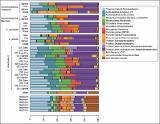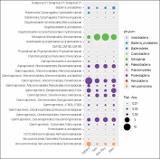Por favor, use este identificador para citar o enlazar a este item:
http://hdl.handle.net/10261/253142COMPARTIR / EXPORTAR:
 SHARE SHARE
 CORE
BASE CORE
BASE
|
|
| Visualizar otros formatos: MARC | Dublin Core | RDF | ORE | MODS | METS | DIDL | DATACITE | |

| Título: | Sleeping with the enemy: unravelling the symbiotic relationships between the scale worm Neopolynoe chondrocladiae (Annelida: Polynoidae) and its carnivorous sponge hosts |
Autor: | Taboada, S. CSIC ORCID CVN; Serra Silva, Ana; Díez-Vives, Cristina CSIC ORCID; Neal, Lenka; Cristobo, Francisco J.; Ríos, Pilar; Hestetun, Jon Thomassen; Clark, Brett; Rossi, Maria Eleonora; Junoy, Juan; Navarro, Joan CSIC ORCID ; Riesgo Gil, Ana | Palabras clave: | Bioluminescence Confocal Microbiome MicroCT Molecular connectivity Mutualism Stable isotopes Trophic relationships |
Fecha de publicación: | sep-2021 | Editor: | Linnean Society of London | Citación: | Zoological Journal of the Linnean Society 193(1): 295-318 (2021) | Resumen: | The North Atlantic deep-water polynoid worm Neopolynoe chondrocladiae is involved in an exceptional symbiotic relationship with two hosts: the carnivorous sponges Chondrocladia robertballardi and Chondrocladia virgata. While this is an obligate symbiotic relationship, its real nature is unclear. We used a multidisciplinary approach to narrow down the type of symbiotic relationship between symbiont and hosts. Molecular connectivity analyses using COI and 16S suggest that N. chondrocladiae has high potential for dispersal, connecting sites hundreds of kilometres apart, likely aided by oceanographic currents. Microbial analyses on different anatomical parts of five Chondrocladia species suggest that the presence of the worm in C. robertballardi does not affect the microbiome of the sponge. MicroCT analysis on N. chondrocladiae show that it has dorsally oriented parapodia, which might prevent the worm from getting trapped in the sponge. A faecal pellet recovered from the worm suggests that the polynoid feeds on the crustacean prey captured by the sponge, something corroborated by our stable isotope analysis. Light and confocal microscopy images suggest that N. chondrocladiae elytra produce bioluminescence. We propose that the worm might use bioluminescence as a lure for prey (increasing the food available for both the sponge and the polynoid) and thus fuelling a mutualistic relationship | Descripción: | 24 pages, 8 figures, 5 tables, supporting Information and supplementary data https://doi.org/10.1093/zoolinnean/zlaa146 | Versión del editor: | https://doi.org/10.1093/zoolinnean/zlaa146 | URI: | http://hdl.handle.net/10261/253142 | DOI: | 10.1093/zoolinnean/zlaa146 | ISSN: | 0024-4082 | E-ISSN: | 1096-3642 |
| Aparece en las colecciones: | (ICM) Artículos (IEO) Artículos |
Ficheros en este ítem:
| Fichero | Descripción | Tamaño | Formato | |
|---|---|---|---|---|
| Taboada_et_al_2021_postprint.pdf | 1,6 MB | Adobe PDF |  Visualizar/Abrir | |
| Taboada_et_al_2021_suppl_fig_1.pdf | 511,36 kB | Adobe PDF |  Visualizar/Abrir | |
| Taboada_et_al_2021_suppl_fig_2.pdf | 116,85 kB | Adobe PDF |  Visualizar/Abrir | |
| Taboada_et_al_2021_suppl_fig_3.pdf | 231,23 kB | Adobe PDF |  Visualizar/Abrir | |
| Taboada_et_al_2021_suppl_table.xlsx | 434,77 kB | Microsoft Excel XML | Visualizar/Abrir |
CORE Recommender
SCOPUSTM
Citations
8
checked on 22-abr-2024
WEB OF SCIENCETM
Citations
6
checked on 27-feb-2024
Page view(s)
102
checked on 29-abr-2024
Download(s)
87
checked on 29-abr-2024
Google ScholarTM
Check
Altmetric
Altmetric
NOTA: Los ítems de Digital.CSIC están protegidos por copyright, con todos los derechos reservados, a menos que se indique lo contrario.
